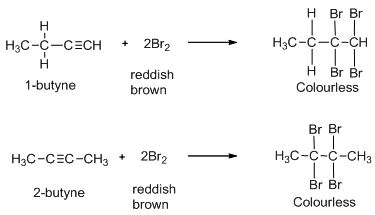
The compounds 1-butyne and 2-butyne can be distinguished by using:
A.Bromine water
B.
C.Tollen’s reagent
D.Chlorine gas
Answer
427.8k+ views
Hint: The hydrogen atoms that are attached to the triply bonded carbon are weakly acidic in nature and hence they can form acetylides with heavy metallic salts.
Complete step by step answer:
The two given alkynes are 1-butyne and 2-butyne. Their structures are shown below:

Due to the presence of two pi-bonds, alkynes can undergo a number of additional reactions in which alkynes can add two molecules of a reagent unlike alkenes which can add only one reagent molecule due to the presence of only one pi-bond.
First, let us consider the reaction of both the alkynes with bromine water. Bromine water solution is a deep reddish brown colored solution. When bromine solution is added dropwise to an alkyne, the reddish brown colour disappears because the product is colourless. Thus, both 1-butyne and 2-butyne decolourise bromine water solution. Hence, bromine water tests cannot be used to distinguish between them. So, the option (A) is incorrect.

Now, let us consider the reaction of both the alkynes with

Now, consider the reaction with Tollen’s reagent. Tollen’s reagent is a chemical reagent which consists of a solution of silver nitrate, ammonia and some sodium hydroxide. Due to the acidic nature of the hydrogen atoms attached to the triply bonded carbon, terminal alkynes react with heavy metallic salts like silver nitrate. Since 1-butyne is a terminal alkyne, it will react with Tollen’s reagent while 2-butyne will not react as it is an internal alkyne.


So, this test can be used to distinguish between them. So, the option (C) is correct.
Lastly, both 1-butyne and 2-butyne will undergo an addition reaction with chlorine. So, option (D) is also incorrect.

Hence option C is correct.
Note:
Alkynes having a terminal carbon-carbon triple bond when treated with ammoniacal solution of
Complete step by step answer:
The two given alkynes are 1-butyne and 2-butyne. Their structures are shown below:

Due to the presence of two pi-bonds, alkynes can undergo a number of additional reactions in which alkynes can add two molecules of a reagent unlike alkenes which can add only one reagent molecule due to the presence of only one pi-bond.
First, let us consider the reaction of both the alkynes with bromine water. Bromine water solution is a deep reddish brown colored solution. When bromine solution is added dropwise to an alkyne, the reddish brown colour disappears because the product is colourless. Thus, both 1-butyne and 2-butyne decolourise bromine water solution. Hence, bromine water tests cannot be used to distinguish between them. So, the option (A) is incorrect.

Now, let us consider the reaction of both the alkynes with

Now, consider the reaction with Tollen’s reagent. Tollen’s reagent is a chemical reagent which consists of a solution of silver nitrate, ammonia and some sodium hydroxide. Due to the acidic nature of the hydrogen atoms attached to the triply bonded carbon, terminal alkynes react with heavy metallic salts like silver nitrate. Since 1-butyne is a terminal alkyne, it will react with Tollen’s reagent while 2-butyne will not react as it is an internal alkyne.


So, this test can be used to distinguish between them. So, the option (C) is correct.
Lastly, both 1-butyne and 2-butyne will undergo an addition reaction with chlorine. So, option (D) is also incorrect.

Hence option C is correct.
Note:
Alkynes having a terminal carbon-carbon triple bond when treated with ammoniacal solution of
Recently Updated Pages
Express the following as a fraction and simplify a class 7 maths CBSE

The length and width of a rectangle are in ratio of class 7 maths CBSE

The ratio of the income to the expenditure of a family class 7 maths CBSE

How do you write 025 million in scientific notatio class 7 maths CBSE

How do you convert 295 meters per second to kilometers class 7 maths CBSE

Write the following in Roman numerals 25819 class 7 maths CBSE

Trending doubts
State and prove Bernoullis theorem class 11 physics CBSE

What are Quantum numbers Explain the quantum number class 11 chemistry CBSE

Write the differences between monocot plants and dicot class 11 biology CBSE

Who built the Grand Trunk Road AChandragupta Maurya class 11 social science CBSE

1 ton equals to A 100 kg B 1000 kg C 10 kg D 10000 class 11 physics CBSE

State the laws of reflection of light




